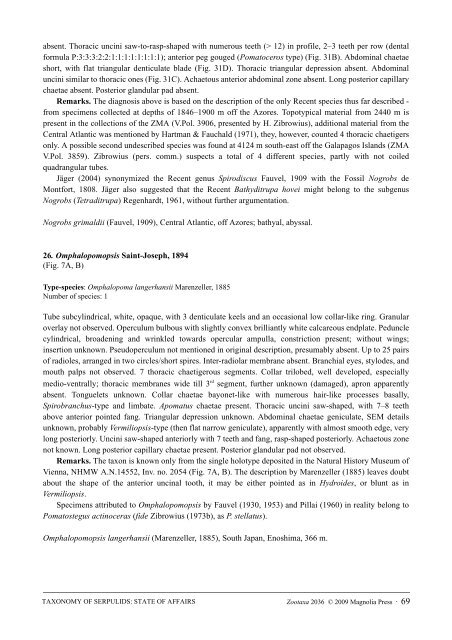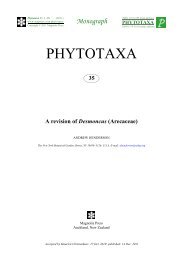Zootaxa, Taxonomy of Serpulidae (Annelida ... - Magnolia Press
Zootaxa, Taxonomy of Serpulidae (Annelida ... - Magnolia Press
Zootaxa, Taxonomy of Serpulidae (Annelida ... - Magnolia Press
You also want an ePaper? Increase the reach of your titles
YUMPU automatically turns print PDFs into web optimized ePapers that Google loves.
absent. Thoracic uncini saw-to-rasp-shaped with numerous teeth (> 12) in pr<strong>of</strong>ile, 2–3 teeth per row (dental<br />
formula P:3:3:3:2:2:1:1:1:1:1:1:1:1); anterior peg gouged (Pomatoceros type) (Fig. 31B). Abdominal chaetae<br />
short, with flat triangular denticulate blade (Fig. 31D). Thoracic triangular depression absent. Abdominal<br />
uncini similar to thoracic ones (Fig. 31C). Achaetous anterior abdominal zone absent. Long posterior capillary<br />
chaetae absent. Posterior glandular pad absent.<br />
Remarks. The diagnosis above is based on the description <strong>of</strong> the only Recent species thus far described -<br />
from specimens collected at depths <strong>of</strong> 1846–1900 m <strong>of</strong>f the Azores. Topotypical material from 2440 m is<br />
present in the collections <strong>of</strong> the ZMA (V.Pol. 3906, presented by H. Zibrowius), additional material from the<br />
Central Atlantic was mentioned by Hartman & Fauchald (1971), they, however, counted 4 thoracic chaetigers<br />
only. A possible second undescribed species was found at 4124 m south-east <strong>of</strong>f the Galapagos Islands (ZMA<br />
V.Pol. 3859). Zibrowius (pers. comm.) suspects a total <strong>of</strong> 4 different species, partly with not coiled<br />
quadrangular tubes.<br />
Jäger (2004) synonymized the Recent genus Spirodiscus Fauvel, 1909 with the Fossil Nogrobs de<br />
Montfort, 1808. Jäger also suggested that the Recent Bathyditrupa hovei might belong to the subgenus<br />
Nogrobs (Tetraditrupa) Regenhardt, 1961, without further argumentation.<br />
Nogrobs grimaldii (Fauvel, 1909), Central Atlantic, <strong>of</strong>f Azores; bathyal, abyssal.<br />
26. Omphalopomopsis Saint-Joseph, 1894<br />
(Fig. 7A, B)<br />
Type-species: Omphalopoma langerhansii Marenzeller, 1885<br />
Number <strong>of</strong> species: 1<br />
Tube subcylindrical, white, opaque, with 3 denticulate keels and an occasional low collar-like ring. Granular<br />
overlay not observed. Operculum bulbous with slightly convex brilliantly white calcareous endplate. Peduncle<br />
cylindrical, broadening and wrinkled towards opercular ampulla, constriction present; without wings;<br />
insertion unknown. Pseudoperculum not mentioned in original description, presumably absent. Up to 25 pairs<br />
<strong>of</strong> radioles, arranged in two circles/short spires. Inter-radiolar membrane absent. Branchial eyes, stylodes, and<br />
mouth palps not observed. 7 thoracic chaetigerous segments. Collar trilobed, well developed, especially<br />
medio-ventrally; thoracic membranes wide till 3 rd segment, further unknown (damaged), apron apparently<br />
absent. Tonguelets unknown. Collar chaetae bayonet-like with numerous hair-like processes basally,<br />
Spirobranchus-type and limbate. Apomatus chaetae present. Thoracic uncini saw-shaped, with 7–8 teeth<br />
above anterior pointed fang. Triangular depression unknown. Abdominal chaetae geniculate, SEM details<br />
unknown, probably Vermiliopsis-type (then flat narrow geniculate), apparently with almost smooth edge, very<br />
long posteriorly. Uncini saw-shaped anteriorly with 7 teeth and fang, rasp-shaped posteriorly. Achaetous zone<br />
not known. Long posterior capillary chaetae present. Posterior glandular pad not observed.<br />
Remarks. The taxon is known only from the single holotype deposited in the Natural History Museum <strong>of</strong><br />
Vienna, NHMW A.N.14552, Inv. no. 2054 (Fig. 7A, B). The description by Marenzeller (1885) leaves doubt<br />
about the shape <strong>of</strong> the anterior uncinal tooth, it may be either pointed as in Hydroides, or blunt as in<br />
Vermiliopsis.<br />
Specimens attributed to Omphalopomopsis by Fauvel (1930, 1953) and Pillai (1960) in reality belong to<br />
Pomatostegus actinoceras (fide Zibrowius (1973b), as P. stellatus).<br />
Omphalopomopsis langerhansii (Marenzeller, 1885), South Japan, Enoshima, 366 m.<br />
TAXONOMY OF SERPULIDS: STATE OF AFFAIRS<br />
<strong>Zootaxa</strong> 2036 © 2009 <strong>Magnolia</strong> <strong>Press</strong> · 69
















